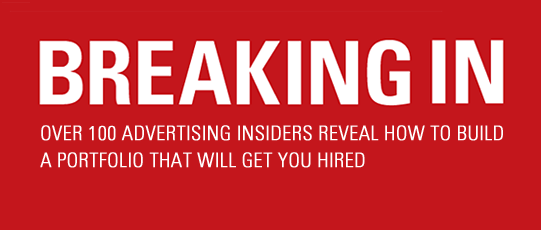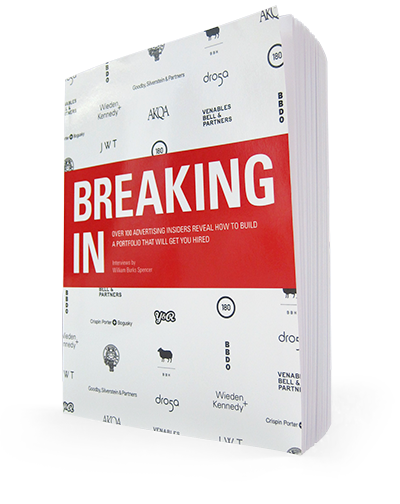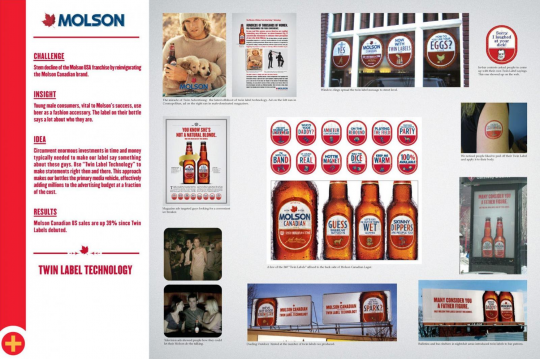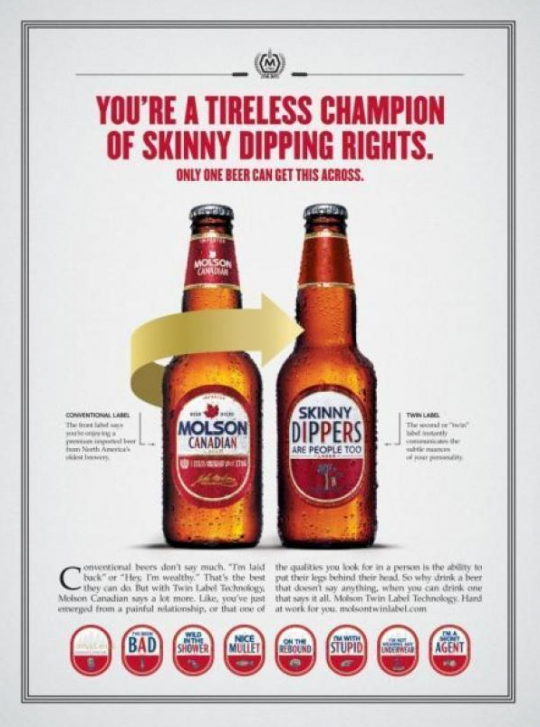Burger King – “Subservient Chicken”
Burger King – “Whopper Sacrifice” Case Study
Burger King – “Whopper Freakout” Case Study
Ugoff
VW – “Safe Happens” Case Study
Microsoft
MINI – “This is America”
MINI – Counterfeit Mini
Virgin Atlantic – “Suite & Innocent” – Free Adult Video offered on Hotel TV Systems
Truth
Molson
Andrew Keller on Fora.tv – “How Advertising Works”
CP+B Employee Handbook
Edited email from Andrew Keller to all employees of Crispin Porter+Bogusky.
WARNING: this is very long and dense. I don’t expect you to memorize it or even internalize it, hell you might not even read all of it. But I wanted to start a conversation with everyone by throwing the whole kitchen sink at you.
I say this because it’s important that we all take a breath, look down and realize that the clay is in our hands. We can make it what we want. Not just the work, but our future. I’ve been thinking a lot about where we are headed as an agency, where the industry is headed and where culture is headed. And I want to share some of that with you so that it’s all in our brains as we do this game changing work. It’s important that we step back to see the big picture and make sure we are working to change culture to benefit our brands and change our brands to benefit culture.
We live to challenge the status quo and redefine categories. And redefine our industry. We live to make an impact on-culture, pop culture, business, products, financial results. We love to make change–to see the effect of what we do. It starts with the belief that culture wants to change. So we do our part and give it a good nudge.
We don’t do “art”–what we do is not about beauty or reflecting life as it is. It’s about challenging the conventions of culture, the accepted beliefs of our time and our clients’ categories to put a spotlight on what makes them special and has always made them special. We use tension to illuminate their transcendent meaning and make it relevant for today.
A lot has changed in the last decade. People are even more hyper-connected now. We all carry phones with cameras and video cameras in our pockets that are perpetually connected to the Internet. People are the chief content creators. People are the chief content distributors. The entire Internet has been re-architected around people and people-systems. Social media has pervaded our life and in the process its created a new social contract for people and brands.
This new condition has changed the expectations for how consumers experience brands. The expectation of the relationship has become far more intimate. Brands, especially big brands, have the opportunity and expectation to become as intimate with a consumer as a small local business or even a friend.
Because of this, the expectations for honesty, ideals and meaning are high and represent huge opportunities. Brands have to be multidimensional, more human. Brands have stood for simple things in the past: A better mousetrap, the highest quality widget. These things are what they make. But these days people also want to know “why.” This has fundamentally changed branding and it’s been accelerated by a digital and social ethos. It’s not enough to be great at something or to be an expert in your field. The world is buying your bigger mission, in many cases, first. This has to pervade and drive a brand’s messaging and actions no matter what the “media.”
There has been a lot of talk about social media. It’s fascinating and powerful. But its most profound impact isn’t the literal silo of “social media” as we think of it today. The important part is how it’s changing our brains and the way we interact with brands and our expectations of these brands. So as we move forward, we’re going to be talking more and more about moving social to the core of what we do. And, we don’t mean a different media approach. We need a fundamentally different way to create a brand: the way it talks, behaves and thinks and the way to leverage ALL touch points–especially those beyond the obvious “social” touch points like TV. The opportunity is to build a brand that is relevant and explosive within the world’s new social contract and to socialize old media points, uncover/activate new touch points and bring it all together to create a system that connects people to a brand.
It starts with strategy.
Our strategy more and more each day sits at the intersection of the cogs (cognitive anthropologists, planners), UX and media. When you consider the things that this evolving marketing viewpoint brings with it–24/7 communications, a perceived intimacy and real time transparency–a brand needs to know who it is more now than ever. And what it stands for. What we may think of as liabilities have to be turned into opportunities. Silence creates suspicion now. There has never been so much simultaneous demand and opportunity for brands to communicate their values. Jim Stengel talks about the power of this in (his book) Grow–the fact that brands with strong, known values outperform the S&P 500. And when you intersect this value-centric brand opportunity with our social world, the stakes are raised or, better put, the opportunity is enhanced ten-fold for those that leverage it.
Domino’s is an excellent example of this. We know what we stand for, we know who we are. And we did what we thought was right and it’s changed everything. And we’ve done it from TV to apps to online retail ordering and tracking to recruiting. It’s a full circle that your consumer wants to get on the inside of. And it starts with a brand’s “why” because without it you can’t have a real conversation. And there are so many conversations you need to have. So many touch points and people and perspectives need to be addressed, engaged and inspired. So we start with who a brand is, what the target mindset is and what are the shared values between them and then how does the brand’s ecosystem and the consumers’ user journey collide in fortuitous ways to create action, conversation and conversion that cements them to the brand.
The next step is content creation.
Every touch point is an opportunity to prove who you are. To do this requires creation of assets that can help literally and philosophically tell the story. Icons, characters, employees: Best Buy blueshirts, Domino’s employees, tangible assets etc. All of these inventions can help a brand talk and relate where a product or logo can’t.
And it often comes down to the little things we say. With MINI we wrote and crafted the legal lines on ads. Those are opportunities to show the lights are on. That someone is home. The personality, the story is in the details. And there are so many details. We’ve always loved the small but huge “media” opportunities that most agencies overlook. These define a brand. I’ve always believed that if you are nice most of the time but you show a dark side once, people believe they’ve gotten a sneak peak into the REAL you. We are wired to read between the lines. It’s what a politician says when he’s off mic that we find more compelling–especially when they think they are off mic and they aren’t. That becomes the brand truth. So we have to embrace that. The details, the hidden opportunities, the 140 characters will tell this new world who your brand really is.
This philosophy has to find ways to spread to every touch point. Even in the realm of TV. There is interactive TV (Whopper Lust), there is the opportunity to build apps and leverage social networks to enhance the TV/movie experience (Best Buy movie mode, Old Navy Shazam), but also the approach to the content just needs to evolve as well. We’ve always worked with press releases to develop ideas. It’s not about getting press for the sake of press, it’s about understanding the expectation of impact within an idea as you concept it, vet it and create it. It’s about understanding what will drive the conversation and illuminate the message in a spectacular way. That’s what we live for. But also, don’t underestimate the fact that a simple, well written, brilliantly executed big idea can still change the world by simply challenging the way we think. Our Ikea “Lamp” spot did this. The Windows phone launch work did this. 30 seconds of culture changing words and images.
Now in the life of a brand there is a continuous stream of actions every day and they all can’t try to create a huge news day for a brand. We also need to create snackable content, bits and bites–shareable, playable, postable quips that maintain our strong relationship and give the world something to talk about. In these spaces our press release technique begins to evolve into tweets-the more intimate version of a press release. Where the result can be called social currency.
And, not surprisingly, sometimes people would rather talk about themselves than our brand. So how does our brand become a vehicle or conduit for THEIR story? Our brand has to know and communicate our story but it has to also be able to tell the consumer’s story, literally. Understanding this potential for contribution is key because this may be more valuable to them than the product or service itself. That’s the future of word of mouth. Ultimately when it all comes together, real magic happens. It’s way more than an integrated campaign. It’s literally a new way to go to market, to create and grow a brand that drives powerful results.
The third key element in this is production, development and operational touch point integration. Digital production and invention is not an afterthought or output. As a social approach to all marketing and a social ecosystem starts to come to life for a brand we know that values and voice are key to delivering that brand. And we know the old corporate identity elements of color, sound, logo, type still work to connect a brand. But more and more importantly the interactions themselves and the opportunity to connect and share with the brand-the literal functionality-becomes a key branded element. The interaction itself must feel right and repeatable and ownable. Also as mobile and tablet become the first screen, we can’t just piggy back on what exists; future experiences are ours to create. It’s about way more than watching and announcing and each one of these consumption and action opportunities can be branded from start to finish. And it has to be. That’s why we are so deeply involved with this work for our clients. The pieces of the ecosystem have to come from one place, share a voice, a flow and a functionality that literally IS the brand. Also, brands have more and more technology and data lying around that can be leveraged more visibly to tell their story. Pizza Tracker is this. An operational, internal checks and balances system that has become a confidence builder for mom, a game for her kids, a business accelerator for Domino’s and a new communications platform with the consumer.
So whatever you want to call it–marketing, advertising, Hollywood meets Silicon Valley, branding, inventing–it’s never been more exciting. But brands will need to be made ready for this world, this new social contract, and then activated. So, are you awakening to the cultural shifts in consumer/brand relationships that should be impacting everything you do today? Is your brand ready? What can you do now to make sure it is? Are you leveraging every touch point opportunity? How will you build a brand that the world can believe in, that matters?






Comments are closed.